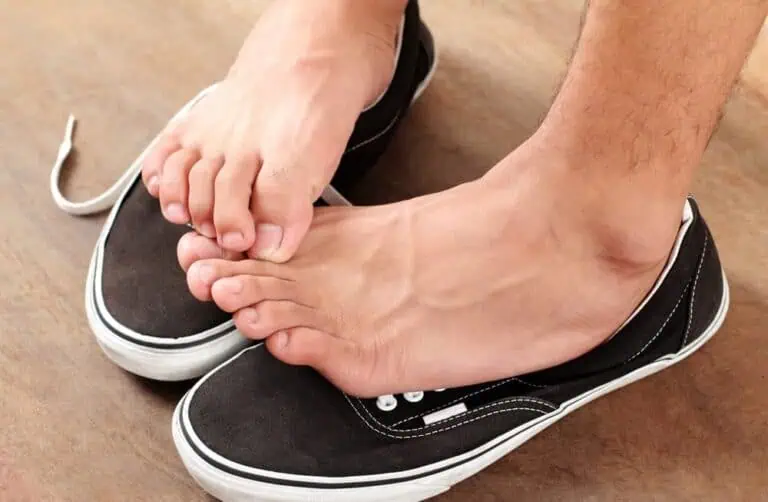How to Get Rid of Athlete’s Foot

The burning and itching of athlete’s foot is bad enough. When you add ugly, cracked, scaly skin, the condition can go from irritating to embarrassing. If you have it, you’re probably wondering how to get rid of athlete’s foot permanently and in a hurry. Treating this foot fungus ASAP is key to banishing it, so read on to discover athlete’s foot treatments that work.
What is athlete’s foot?
Athlete’s foot, also known as tinea pedis or ringworm of the foot, is a fungal skin infection of the foot. Athlete’s foot symptoms include an itching, burning rash, cracked, scaly skin and small blisters. The rash often occurs between the toes, but it can affect the bottom and sides of the feet in a type called moccasin athlete’s foot.
Athlete’s foot probably won’t go away on its own, so don’t ignore it. If you leave it to fester, you could end up with large, painful cracks (fissures) that let bacteria in. What’s more, the fungus could spread to other body parts, including your groin, hands, nails and underarms. You could even spread it to someone else.
What causes athlete’s foot?
Athlete’s foot is caused by a fungus that thrives in warm, humid environments such as locker room floors, gym showers and the sweaty insides of tight-fitting shoes.
Despite the name, you don’t have to be an athlete to develop it. In fact, athlete’s foot is most common in people over 60. Why? A few reasons. If you have trouble reaching your feet, it’s harder to keep them clean and dry and to change your socks as often as you should. Swollen feet, more common in older age, can make shoes too tight. Dry, cracked skin on the feet, common in people with diabetes, also makes the feet more susceptible to fungal invasions.
Athlete’s foot treatment
When it comes to how to get rid of athlete’s foot, the answer is either over-the-counter products or prescription medicines. Over-the-counter products often cure mild to moderate cases, especially when the foot fungus is treated early on, though it may take some trial and error to find the product that works for you. The longer you wait to treat your athlete’s foot, the harder it is to cure, and the more likely the fungus will spread or reoccur.
If over-the-counter treatments aren’t working, you have a severe case or your athlete’s foot comes back, see your dermatology provider, who can prescribe stronger medicine.
Over-the-counter treatments
Over-the-counter treatments for athlete’s foot include creams, sprays and powders that kill or slow the growth of the fungus. Apply them to clean, dry feet, following the directions on the package.
- Athlete’s foot cream or ointment: These contain a medicine such as terbinafine. Spread the cream onto your foot in a thin layer and allow it to dry completely before putting on socks and shoes. If you’re in a rush, choose a spray or powder instead.
- Athlete’s foot spray: Spray may be a good option if you have a hard time reaching your feet or the infection covers a large area. Some sprays contain baking soda and are designed to reduce moisture and odor. Others are liquid.
- Athlete’s foot powder: Powders, such as ones that contain miconazole, may be a good option if you have sweaty feet or recurring infections.
While you’re treating your athlete’s foot, it’s important to practice good foot hygiene to encourage healing. Wash and dry your feet at least once a day. Change your socks daily and wash them in hot water. Switch shoes every day or two to give each pair a chance to dry out between wearings.
Prescription treatments
If an over-the-counter product hasn’t cured your athlete’s foot after two weeks of dedicated treatment, make an appointment to see your dermatologist, who can attack the problem with stronger medicine.
Prescription athlete’s foot treatments include creams and ointments such as ciclopirox, econazole and clotrimazole. Because they are powerful, be sure to apply them exactly as directed.
Your dermatology provider may prescribe an oral medication for athlete’s foot if your case is severe or doesn’t respond to topical treatments. These antifungals need to be taken for several weeks or months, and they come with potential side effects, so you and your doctor should weigh the risks and benefits.
Preventing athlete’s foot
As with so many health conditions, prevention is the best medicine when it comes to athlete’s foot. These strategies will reduce your risk:
- Keep your feet clean and dry.
- Wear shoes, flip-flops or slippers in wet, humid or communal areas, including public gyms and pools and hotel rooms.
- Dry your feet thoroughly after the beach or pool before putting your shoes back on.
- Wear shoes that fit well.
- Favor sandals when possible to let your feet breathe.
- Choose socks made of moisture-wicking fabric such as a wool or polyester blend. The 100% cotton socks in your drawer are not the best choice for moving moisture away from your feet.
- Change your socks daily and after workouts.
- Don’t share shoes, socks or towels.
Medically reviewed by Toluwalase Ogunsola, APRN
Written by Johanna Neeson, a health and lifestyle writer in New York City. Her work focuses on dermatology, pediatrics, and autoimmune diseases and has appeared on Everyday Health, MSN, Reader’s Digest, and other publications.


